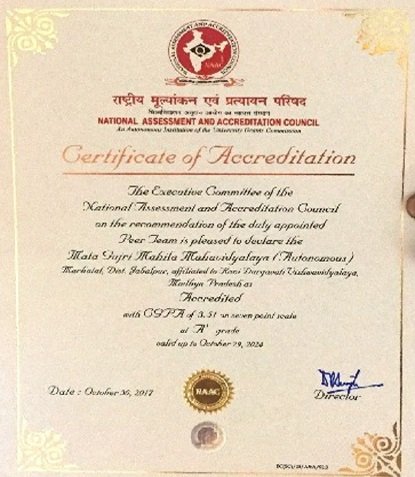The NATIONAL ASSESSMENT AND ACCREDITATION COUNCIL (NAAC) is an autonomous body established by the University Grants Commission (UGC) of India to assess and accredit institutions of higher education in the country. It is an outcome of the recommendations of the National Policy in Education (1986) which laid special emphasis on upholding the quality of higher education in India.
For ease of reference, the following details are excerpted from NAAC Website.
Rationale: Assessment and Accreditation is broadly used for understanding the "Quality Status" of an institution. In the context of Higher Education, the accreditation status indicates that the particular Higher Educational Institutions (HEI) - a College, a University, or any other recognised Unit therein, meets the standards of quality as set by the Accreditation Agency, in terms of its performance, related to the educational processes and outcomes, covering the curriculum, teaching-learning, evaluation, faculty, research, infrastructure, learning resources, organisation, governance, financial well being and student services.
Grades: Institutions are graded for each Key Aspect under four categories, viz. A, B, C and D, denoting Very good, Good, Satisfactory and Unsatisfactory levels respectively. The summated score for all the Key Aspects under a Criterion is then calculated with the appropriate weightage applied to it and the GPA is worked out for the Criterion. The Cumulative GPA (CGPA), which gives the final Assessment Outcome, is then calculated from the seven GPAs pertaining to the seven criteria, after applying the prescribed weightage to each Criterion.
Process: NAAC's process of assessment is towards holistic, systematic, objective, data-based, transparent and shared experience for institutional improvement. The process for assessment and accreditation broadly consists of:
Criteria:: NAAC scores are based on the following criteria
Assessment Outcomes: There are two outcomes of Assessment and Accreditation:
Peer Team Report
The qualitative part of the outcome is called Peer Team Report (PTR) which is an objective report prepared by the Team highlighting its evaluative judgements, mostly using precise keywords instead of long sentences.
Institutional Grading
The quantitative part of the outcome comprises the criterion-wise quality assessment, resulting in the final Cumulative Grade Point Average (CGPA), a letter grade and a performance descriptor. The CGPA and letter grade constitute the certification by the NAAC on institutional accreditation.

MATA GUJRI MAHILA MAHAVIDYALAYA happily received a 'A' grade in the first cycle of NAAC evaluation in 2007, demonstrating our early commitment to providing high-quality education. This accomplishment strengthens our commitment to constant development and guarantees that every student has a remarkable educational experience. We are grateful to our community for their part in making this accomplishment possible.

“In a remarkable testament to sustained excellence, Mata Gujri Mahila Mahavidyalaya proudly achieved an 'A' grade once again in the second cycle of the NAAC assessment. This dual acknowledgement reflects our enduring commitment to providing top-tier education and fostering a culture of continual improvement.”

“Thriving on a legacy of excellence, Mata Gujri Mahila Mahavidyalaya reaches new heights by attaining an 'A+' grade in the third cycle of the NAAC assessment. This accomplishment underscores our unwavering commitment to providing unparalleled education and signifies a continual journey towards academic brilliance.